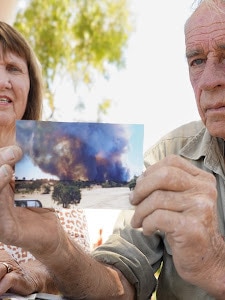The trauma from one of South Australia’s worst bushfires is still being felt a decade after it ripped through the southern Flinders Ranges.
Key points:
- A sheep farmer is still rebuilding after the disastrous blaze
- The fire fostered a relationship between the Port Pirie aerodrome and the Country Fire Service
- Residents in fire-prone areas are urged to be as prepared as possible for crisis situations
The Bangor bushfire burnt through inaccessible terrain and scrubland for 31 days and destroyed homes, farms and businesses.
Margot Blesing, the owner of Blesing’s Garden Wines in Bangor, said she saw the fire when she went outside to cool off during a thunderstorm after what had been a very hot day.
“I looked up and in the distance I could see the smoke,” she said.
“So I immediately called the man who lived up the road to warn him.
“That was the beginning of the first of four fires that they discovered at that time.
“[At first the CFS] didn’t discover the fourth fire, which eventually became the Bangor bushfire.”
Loading…
The Blesings’ property was impacted by the fire on four separate occasions, burning 70 per cent of their land.
The vines were not burnt, but that season’s vintage was discarded due to smoke taint.
“There’s no insurance for that,” Ms Blesing said.
“We had a massive loss of income.”
Mrs Blesing said that time had a habit of healing wounds, but she would never forget the scenes she witnessed.
‘Everything around here was black’
Robin Pole’s property was completely surrounded by fire and he can still remember the constant smell of smoke.
“The fire was a kilometre down the road, so everything around here was black,” he said.
The sheep farmer lost the majority of his property in Wirrabara, as well as 180 sheep.
“Instead of having a straight number of sheep every year, you keep a certain amount, you sell a certain amount every year,” Mr Pole said.
“It meant I had to keep some of my older sheep for a bit longer, and that’s only really just evened out.
“I had an awful amount of fencing to do, which I still have — I haven’t finished.”
Despite the losses, Mr Pole considers himself lucky.
“For us, it started on Tuesday and by Friday night, for us, it was all over, because our country that was going to be affected had already been burnt, sheep lost, fences lost,” he said.
“Other people in the community spent a month not knowing.”
Communities urged to be prepared
Hundreds of firefighters and farmers battled the Bangor fire for 31 days and the Country Fire Service (CFS) utilised the Port Pirie aerodrome for the first time.
Aerodrome manager Steve Joyce witnessed first-hand how important the CFS’s aerial bombers were in suppressing the fire.
“They work so well to protect assets and people and houses, and it really inspired me to say, ‘We need this at Port Pirie as the area,'” he said.
Mr Joyce developed a close relationship with the aviation team.
“I should be part of this,” he recalled thinking.
“In fact, why haven’t I done this earlier?”
The Port Pirie aerodrome is now a permanent air base for the CFS.
“The community knows there is a dedicated aviation team here, ready to help,” Mr Joyce said.
CFS Region 4 Commander Sindy McCourt was a regional planning officer during the Bangor fire and said there could never be enough resources to prevent losses from a blaze of that scale.
“It leads back to the communities being prepared for a significant event,” she said.
“While we will do the absolute best we can to protect livestock and property, we only have so many appliances.”
Commander McCourt said it was important to take the time to create a five-minute bushfire plan.
Posted , updated




